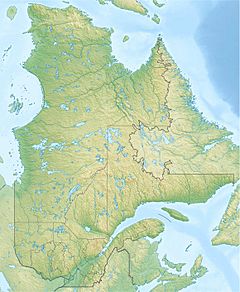Toulnustouc River facts for kids
Quick facts for kids Toulnustouc River |
|
|---|---|
| Native name | Kuetutnustuku Shipu |
| Other name(s) | Rivière Toulnustouc |
| Country | Canada |
| Province | Quebec |
| Territory | Côte-Nord |
| RCM | Manicouagan |
| Unorg. territory | Rivière-aux-Outardes, |
| Physical characteristics | |
| Main source | Lac Dechêne 51°13′19″N 67°49′59″W / 51.222041°N 67.83311°W |
| River mouth | Manicouagan River Rivière-aux-Outardes 49°35′37″N 68°23′36″W / 49.59361°N 68.39333°W |
| Length | 253 kilometres (157 mi) |
| Basin features | |
| Basin size | 11,111 square kilometres (4,290 sq mi) |
| NRC Id | EIHVH |
The Toulnustouc River (which is Rivière Toulnustouc in French) is a river in Quebec, Canada. It flows into the Manicouagan River in a place called Rivière-aux-Outardes. This river is part of the Côte-Nord region.
The Toulnustouc River is very important for making electricity. A big dam on the river creates Lake Sainte-Anne. This lake helps control the water for huge power plants near the Manicouagan River. It also feeds the Toulnustouc generating station, which started working in 2005 and can produce a lot of power (526 MW).
Contents
What is the Toulnustouc River Like?
In 1914, a book called Dictionnaire des rivières et lacs de la province de Québec described the Toulnustouc River. It said the river was one of the strongest rivers flowing into the Manicouagan River.
TOULNUSTOOK OR TULNUSTUK, (River) -One of the most powerful tributaries of the Manicouagan River in Saguenay County. It is about two hundred feet wide at its mouth where the current is slow and the channel deep. Its direction for the first four miles is North North-East and the current increases all the time to become a rapid at the end of this race. It flows, says Mr. C. H. Valiquette, I. C. (1908), in the middle of a valley three quarters of a mile wide composed of land suitable for cultivation. This valley, as well as the mountains which border it, is very well wooded... Above la Fourche the river runs north-west for the next eleven miles, then the river narrows little by little and the mountains become more bare with very high cliffs. This river is also called Rivière du Coude (Elbow River).
At its mouth, the river is about 60 meters (200 feet) wide. The water there moves slowly, and the river is deep. Further upstream, the current gets faster and turns into rapids. The river flows through a wide valley that used to have good land for farming. This valley and the mountains around it were once covered with many trees.
What Does the Name Toulnustouc Mean?
The name Toulnustouc comes from the Innu language, but its exact meaning is not fully known.
Some people, like surveyor J. Bignell, thought the name meant "elbow river" or "angled river." This idea matches an older name for the river, which was Rivière du Coude (Elbow River).
However, the Geography Commissions of Quebec and Canada have a different idea. They suggest it means "river where they make canoes" or "where canoes are needed."
You might also see the name spelled in different ways, such as Todnustook, Tudnustouk, Tootnustook, Tulnustuk, Toulnustook, and Toulnoustouc.
In the late 1970s, the Innu people called it "Kuetutnustuku Shipu." This name means "river parallel to the Manicouagan River."
Where Does the Toulnustouc River Flow?
The Toulnustouc River flows through an area called Rivière-aux-Outardes.
- The northern part of the river, called Rivière Toulnustouc Nord, starts near Dechêne Lake. This lake is about 15 kilometers (9 miles) east of the Manicouagan Reservoir.
- It flows southeast through Lac Bardoux and Lac Brûleé. Then it turns south towards Lac Caron.
- At Lac Caron, it joins with another part of the river, the Northeast Toulnustouc River. This northeast branch gets its water from the Petit lac Manicouagan.
The Cartier Railway runs alongside the Toulnustouc River for most of its journey.
After these parts join, the main Toulnustouc River flows southeast through Lac Fortin and Lac Bouffard. It then goes south to Lake Sainte-Anne, which is a large reservoir. From there, it flows southwest past Lac Fléché and south into the Réservoir Manic 2. The Manicouagan River also feeds this reservoir.
A big project to build a hydroelectric power plant on the river below Lake Sainte-Anne started in 2001. The Toulnustouc generating station, which produces 526 megawatts of power, began operating in 2005.
How Do People Use the Toulnustouc River?
In the past, the Toulnustouc River was used for logging by a company called Quebec North Shore Paper. This company is now known as Produits Forestier Résolu. There was a difficult event in 1962 when a landslide happened, affecting loggers working near the river.
Today, people enjoy the river for fun activities, especially fishing. Many people come to fish for speckled trout. The areas around the river are also popular for:
- Hunting
- Canoeing
- Boardwalking (walking on special paths)
- Motorcycling
- Snowmobiling
There are also many places along the river where people can go for holidays and relax.


